0 Introduction
Greenhouse gases (GHGs) and air pollutants are both atmospheric pollutants that are derived from similar sources and interact with each other.Global GHG emissions primarily originate from the use of fossil fuels,which also leads to indoor and outdoor air pollution.Climate and environmental issues affect human health directly through more frequent and extreme heat waves,drought and rainstorms,and indirectly through worsening air pollution,fast-spreading diseases,threats to food security and psychological health.Climate change-induced challenges interact with other social and environmental factors causing unprecedented threats to human health.Such threats are likely to undo the progress made in public health over the past half a century.
Recently,China has made progress in combating air pollution and climate change,demonstrating synergistic effects.Since 2013,China has improved its air quality while maintaining growth in its economy and energy consumption.In 2019,the national average concentration of fine particulate matter (PM2.5) declined by 20% from the 2015 level.The concentration of PM2.5 and the number of heavily polluted days in key areas decreased sharply.Taking the“2 + 26” cities (Beijing and Tianjin,and 26 cities around)as an example,compared with 2015,the concentration of PM2.5,the number of heavily polluted days,and the number of days with PM2.5 as the primary pollutant decreased by 28%,45%,and 44%,respectively.Moreover,the concentration of PM2.5 in Beijing decreased from 81 μg/m3 to 42 μg/m3,and the heavily polluted days dropped from 43 days to 4 days [1].China has also attached significant importance to GHG emission reduction.According to an article jointly published by scholars from China,the U.S.,and the Netherlands,China has contributed significantly to GHG reduction by reducing 11 GtCO2e emissions from 1995 to 2014 [2].
While considerable progress has been made in climate change mitigation and air pollution control,the situation of climate change and air quality remains severe in China.It is highly important to explore and study the synergies of CO2 mitigation,air pollution control,and health improvement to fulfill the target of carbon peaking and carbon neutrality.
In this study,section 1 reviews the evolution and research of synergies of energy,climate,and environment in China.Section 2 summarizes the mechanism framework of energy-climate-air-health synergies with multiple chains showing interactions among energy,climate,air pollution and health.Thereafter,a case of the China Energy Interconnection Carbon Neutrality scenario is introduced to support synergies of carbon neutrality,air pollution control,and health improvement in Section 3.Conclusions and policy implications are proposed in Section 4.Note that health discussed in Sections 1 and 2 is broadly referred to as a state of complete physical,mental and social well-being according to WHO (World Health Organization),while in Section 3,the health impacts are narrowly quantified by allcause mortality due to air pollution.
1 Evolution and research of synergies of energy,climate,and environment in China
1.1 Policies on synergies of energy,climate,and environment
Changes in the climate and environmental governance of China are reflected in how its energy,climate,and environmental policies have evolved from mutual independence to inter-restriction to interaction.
At the beginning of reform and opening-up,when the booming Chinese economy spurred the rapid growth in energy demand,the energy policies aimed to support economic growth and energy supply were independent of climate and environmental policies [3].By 2000,China’s GDP increased by more than four times compared with 1980,while energy consumption increased from 600 million tons of standard coal equivalent(tce) in 1980 to 1.46 billion tce in 2000.Meanwhile,in 1979,China adopted its first environmental law,the Environmental Protection Law (Trial),which created a new era in environmental governance.
During the 10th Five Year Plan (FYP,2001-2005),China issued the Plan on Preventing and Controlling Acid Rain and Sulfur Dioxide Pollution in “Two Controls” Regions to mitigate the adverse impacts of acid rain and SO2 emissions on food security and human health.The plan emphasized the control of sulfur coal use and the desulfurization of thermal power plants.However,SO2 emissions increased by the end of the 10th FYP (Fig.1).Therefore,the 11th FYP(2006-2010) specified the ratio of reductions in total SO2 emissions and energy consumption per unit of GDP [4].SO2 emissions finally peaked in 2006 and then dropped.
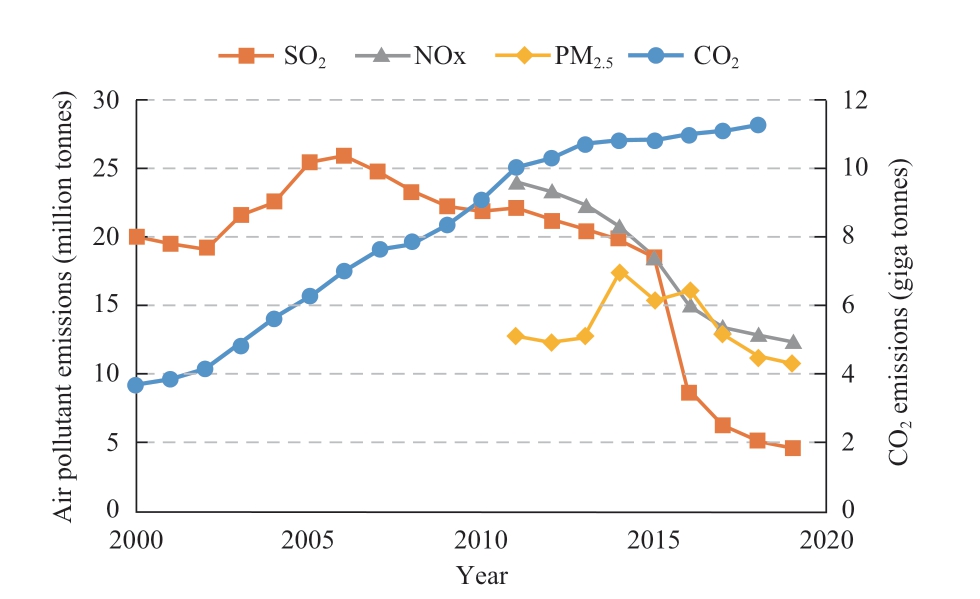
Fig.1 Emissions of carbon dioxide and air pollutants over 2000-2020
The 12th FYP (2011-2015) set the targets of nonfossil energy accounting for 11.4% of primary energy consumption and reducing the carbon intensity by 16.0%.The targets of air pollution control included nitrogen oxides(NOx),requiring that the cumulative NOx emissions during the 12th FYP period drop by 10.0%.Since the target of NOx control was proposed,NOx emissions have decreased year by year (Fig.1).The 12th FYP directly reflected the synergetic control of GHGs and air pollutants.In 2013,the State Council released the Action Plan for the Prevention and Control of Air Pollution,which set out the national targets and measures for air pollution prevention and control,and specified the timetable and action path.After that,PM emissions peaked and then fell.
The 13th FYP included volatile organic compounds(VOCs) control.In addition,two obligatory targets,i.e.,reductions of PM2.5 concentration and the ratio of days with good air quality in cities at and above the prefecture level,were added,reflecting a shift of environmental governance from total amount control to environmental quality improvement [5].In 2018,the State Council issued the Three-year Action Plan to Fight Air Pollution.By the end of 2019,China’s non-fossil energy accounted for 15.3%of energy consumption,equivalent to reducing 5.62 Gt CO2,11.92 Mt SO2,and 11.3 Mt NOx emissions.Synergies between climate change mitigation and air pollution control have appeared [6].
On September 22,2020,Chinese President Xi Jinping officially announced that China will strive to peak CO2 emissions before 2030 and achieve carbon neutrality before 2060.On December 12,it was announced that China will lower its CO2emissions per unit of GDP by over 65% from the 2005 level and increase the share of non-fossil fuels in primary energy consumption to around 25% by 2030.The 14th FYP and the Long-range Objectives Through the Year 2035 specify that green modes of production and living will broadly take shape,carbon emissions will decline steadily after peaking,the ecological environment will be better,and the goal of building a beautiful China will basically be achieved.All these plans will further promote the coordinated governance of climate change,air pollution and environmental pollution,and advance achieving the dual targets of both carbon peak and air quality.
1.2 Research of synergies on carbon emission reduction,air pollution control,and health
Climate change and air pollution derive from similar roots and can easily cause health problems.GHGs and air pollutants such as SO2,NOx,and PM2.5 are primarily attributed to the use of fossil energy.In 2019,global CO2 emissions related to fossil energy reached 36.3 GtCO2,accounting for 86% of total CO2 emissions [7].Coal use,as the main source of SO2 emissions,represents more than half of energy-related SO2 emissions.NOx emissions from oil use account for more than half of the total energy-related emissions.Biomass,which is primarily used in traditionalhousehold stoves,is the main source of PM emissions.The irrational exploitation and utilization of energy adds to global warming and poor air quality and may trigger and aggravate a variety of health issues,including respiratory diseases,cardiovascular diseases and lung cancer,and even death.
The interplay between climate change and air pollution is complex and can have a superposition effect on their damage to human health.Climate change can lower the boundary layer height [8],further increasing the air pollutant concentration.More concentrated PM2.5 in the atmosphere can weaken solar radiation and mitigate climate change.Global warming and the following more ultraviolet radiation will enhance photochemical reactions and increase the ground ozone concentration [9].Excessive ozone exposure can lead to asthma and lung diseases.Changes in humidity,precipitation,and organisms-emitted VOCs resulting from climate change will also affect the formation and growth of PM2.5,which may lead to cardiopulmonary diseases [10].
Various studies focus on synergies of climate change,air pollution,and health aboard [11].On a global scale,Rauner et al.took account of the long chain of “energy-air pollution control-air pollution emissions-chemistry transport modeling-health impact assessment-monetized health impact,” coupled with the global energy-economy general equilibrium model (REMIND),sector-specific emission factor developments (Greenhouse Gas and Air Pollution Interactions and Synergies,GAINS),chemical transport model (TM5-FASST),Integrated Exposure Response (IER)model,Value of a Statistical Life (VSL),and eventually built an assessment model for air quality synergy benefits under the context of climate change [12].Rafaj et al.,with the help of five globally integrated assessment models,quantified the changes in premature deaths caused by air pollution reduction in the decarbonization scenario of the energy system [13].On the regional and national scales,Chowdhury et al.estimated the PM2.5 concentration in India under the RCP4.5 and RCP8.5 scenarios using the CMIP5 (Coupled Model Inter-comparison Project 5) model and evaluated the health level due to PM2.5 exposure [14].Amann et al.assessed the impact of European climate policies on air quality and public health with GAINS,an integrated assessment model [15].
Studies on synergies of climate change,air pollution,and health started late in China but have progressed rapidly.Xing and Lu et al.coupled GCA-China,an integrated assessment model,ABaCAS-EI emission inventory,and CMAQ model [16].According to the results,to achieve the “Beautiful China” target,China will further reduce its emissions of multiple air pollutants by 6%-32% and additionally mitigate CO2 emissions by 22% relative to the NDCs scenarios.The health benefits attributable to improved air quality will be 8 times the additional costs of CO2 mitigation.Li et al.coupled the China TIMES model and GAINS model to assess the benefits of air quality and health improvement brought by achieving the NDCs and the 2 ℃ temperature goal.China’s national carbon emissions trading system will also yield a significant improvement in air quality and health,but this is dependent on the cap set on CO2 emissions.Peaking carbon emissions by 2025 will reduce PM2.5 concentrations by 3%-12% compared with carbon peaking by 2030 [17].
As climate change and air pollution stem from the same source,low-carbon,and emission mitigation policies,which facilitate better air quality,and air pollution control measures,which promote GHGs mitigation,both have positive effects on health.Despite several studies on the synergies of climate change mitigation,air pollution control,and health improvement,there is no systematic mechanism framework for the topic.Moreover,there are few findings with respect to the impacts of China’s carbon neutrality goal on air quality and public health [18].This study proposes a systematic mechanism framework illustrating the synergies of energy,climate,air,and health and applies this framework to analyze the benefits of the China Energy Interconnection Carbon Neutrality scenario,which allocates large-scale energy interconnection.
2 Mechanism frameworks of energy-climateair-health synergies
Climate change and air pollution are fundamentally rooted in energy-related activities.Activities including energy supply,power generation,and end-use energy consumption emit GHGs (e.g.,CO2 and methane) and air pollutants (e.g.,SO2,NOx,and PM2.5),thus affecting the atmospheric environment and climate change.Meanwhile,the economic and social systems interact with energy,climate,and atmospheric systems,ultimately exerting a direct or indirect impact on human health.From the perspective of energy supply,power generation,and enduse consumption,a mechanism framework is given in Fig.2 as follows.

Fig.2 Interactions among energy,climate,air pollution,and health
Chain 1 (Energy-Air): energy-related activities can directly affect human health in the short term by affecting air pollutant emissions.For instance,burning fossil fuels leads to a rise in the concentration of PM2.5 in indoor and outdoor air,further resulting in respiratory diseases and pneumonia.
Chain 2 (Energy-Economy and Society): energy-related activities can affect the economy and society;for example,investment in energy transition can change the structure of fiscal revenue and expenditure.Moreover,energy consumption structure would affect employment,people’s health condition,and social behaviors like choosing the way of travel.
Chain 3 (Energy-Climate): energy-related activities can bring health effects through climate mitigation measures,including adopting clean power generation,supercritical and ultra-supercritical technologies,carbon capture and sequestration in power plants,and adopting low-carbon and energy-efficient technologies in end-users.These measures can effectively reduce CO2 emissions,limit temperature rise,and avoid extreme weather disasters such as heat waves.
Chain 4 (Climate-Economy and Society): climate change can also indirectly affect human health through economic and social issues,such as displaced population,climate change-induced migration,and conflicts.
Chain 5 (Climate-Air): climate change can accelerate oxidation in the atmosphere,thus increasing the concentration of such air pollutants as ozone and affecting human health.
Chain 6 (Climate-Energy): climate change will result in changes in demands for air-conditioning and meanwhile affect the use of clean energy such as wind,solar power,and water.
Chain 7 (Energy-Health): energy exploitation and other activities may cause tragic accidents like mine accidents and disasters and directly lead to human death.
Chain 8 (Health-Energy): remarkable health improvement resulting from the emission reduction measures taken by the energy sector will,in return,incentivize more measures to be implemented,thus facilitating energy transition.
A case of the China Energy Interconnection Carbon Neutrality (CEICN) scenario is applied to illustrate this framework,and the scenario setting is illustrated in detail in Section 3.1.2.In the CEICN scenario,the fossil fuel is reduced,and clean energy is improved to avoid the adverse impacts of energy use on air,climate,and health,as shown in Chains 1,3,and 7,which will be quantified in section 3.4.More energy investment in clean energy in the CEICN scenario will also change the energy mix and improve employment,as illustrated in Chain 2.Chains 4 and 5 show the indirect influence of energy transition on air,economy,and society through the climate system.Moreover,other systems will also influence the energy system,as demonstrated by Chains 6 and 8.However,these indirect impacts (Chains 4 and 5) or hard-to-quantify interactions(Chains 2,6,and 8) are not quantified in the following study.
3 Benefits of the China Energy Interconnection Carbon Neutrality scenario
3.1 Methodology
3.1.1 Integrated assessment of energy,climate,air,and health
Under the mechanism framework of energy-climate-airhealth,an energy-climate-air-health modeling framework was developed in Fig 3.

Fig.3 Energy-climate-air-health modeling Framework
MESSAGE-GLOBIOM integrated assessment model(Model for Energy Supply Strategy Alternatives and their General Environmental Impact-GLObal BIOsphere Model) developed by IIASA (International Institute for Applied Systems Analysis) was used to optimize global and China’s energy systems [19].The energy systems model MESSAGE is coupled with the GLOBIOM model to assess the impact of energy systems on land use,forests,and water resources.This model is a technology-based linear/mixedinteger optimization model taking into account resource exploitation,conversion and transportation,and end-use energy consumption with the objective of minimizing costs.The constraints include temperature control targets,resource potentials,the balance of energy demand and supply.
After the energy systems were optimized,based on GHG emissions,a simplified earth model (BCC_SESM) was used to calculate future atmospheric GHG concentrations,temperature rise,and other climate indicators and further quantify the economic losses caused by climate change to agriculture,forestry,energy,water resources,climate disasters,ecosystems,and other sectors [20].Thereafter,according to emission factors of different energy consumption technologies in industries,transportation,and building sectors,the emissions of SO2,NOx,PM2.5,and other air pollutants were calculated.The concentrations of PM2.5 and ozone (O3) were calculated based on the simplified chemical transport model applied in the GAINS model [26].
Mortality caused by long-term O3 and PM2.5 exposure is used to quantify health impacts in this study.The Relative Risk Model is applied to calculate the number of deaths ΔY.
where Y0 (dimensionless) represents the baseline mortality rate,and P is the population,with data derived from the medium-level population prediction results of the United Nations standard [21].AF (dimensionless) is the attribution factor,equal to 1-1/RR,and RR (dimensionless) is the relative risk to a certain level of health.
The exposure-response function was used to calculate the number of deaths associated with PM2.5 and O3.The relative risk RR in the exposure-response function is a function of change in exposure concentration (c-c0) and health impact parameter β.It is calculated as follows [22].
where c (μg/m3) represents the actual exposure concentration, c0 (μg/m3) is the critical value of exposure concentration that can lead to premature death,which is 7 μg/m3 and 56 μg/m3 for PM2.5 and O3,respectively [23-24];β (m3/μg) the parameter representing the change in adult(≥30) all-cause mortality caused by the unit change in exposure concentration.Global or regional values of β for all-cause and disease-specific mortality are shown in Table 2.0.0030 and 0.0003 were taken for all-cause mortality due to PM2.5 and O3,respectively,implying that per 10 μg/m3 increase in PM2.5 or O3 concentration exposure level resulted in the relative risks of 1.030 and 1.003 [25-31].
Table 1 Key indicators related to energy,air pollutant,and GHGs in Five-Year Plan

Note: ① means the value at the end of FYP,others are the accumulative value of five years.
② Unparenthesized numbers are objectives,while numbers in parentheses are the actual completion.Blue numbers mean the target is achieved,while red means the unachieved.
Controversial as it may be,the monetization of health impacts remains an effective way to evaluate the benefits of climate and environmental policies.VSL depends on local economic development and personal income,as well as the evaluation method;therefore,VSLs for China from different studies show a significantly wide range,as shown in Table 3.In this study,we would not pay effort to the comparison of all these values.We chose 5.1 million CNY as the VSL in 2019,which reflected the willingness of people to pay to reduce the death risk from air pollution in China [16,32].VSL in the model horizon is assumed to increase at the rate of GDP per capita growth with an elasticity of 0.8 [33].
Table 2 All-cause and disease-specific health impact parameters for long-term exposure to PM2.5 and ozone
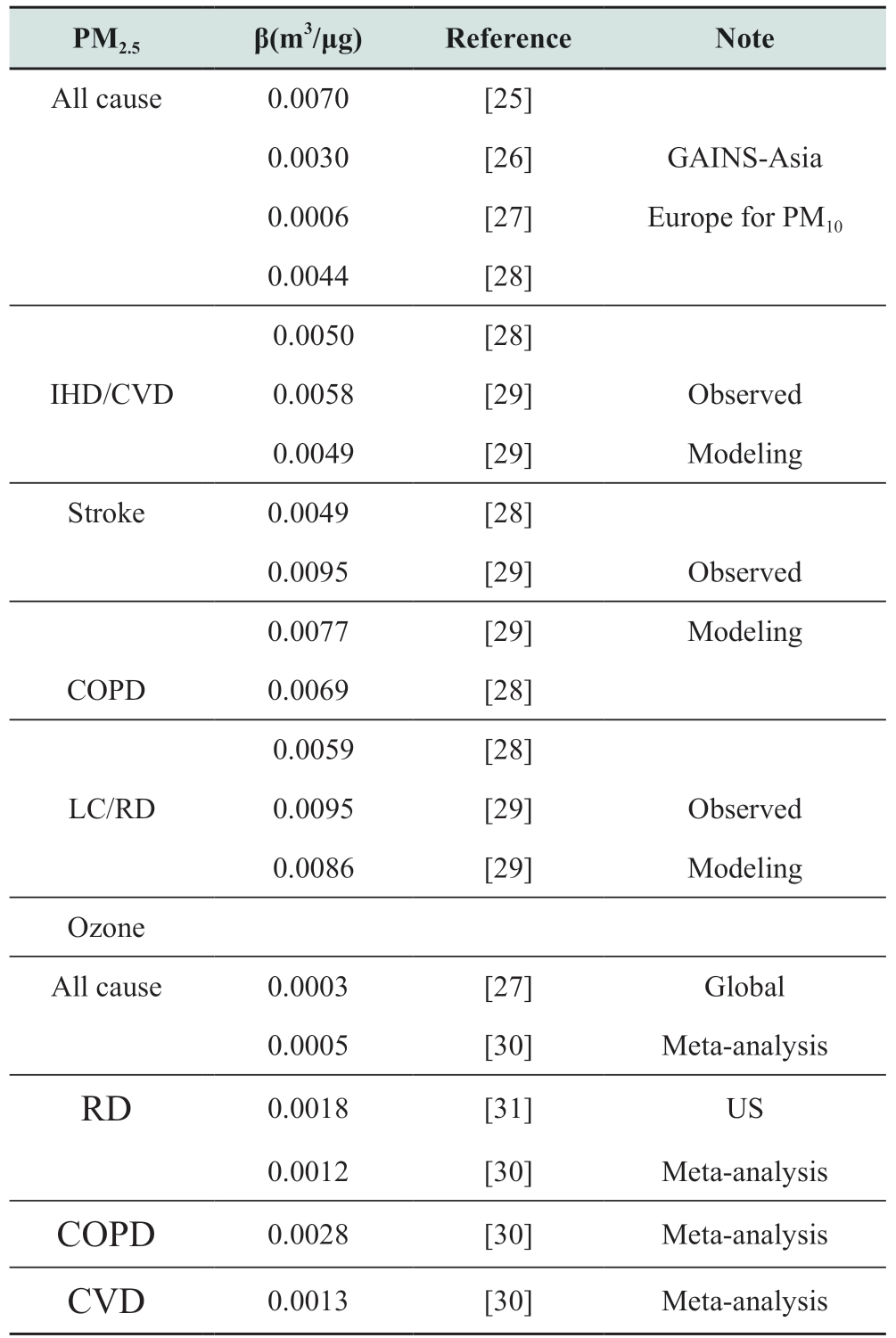
Note: IHD: ischemic heart disease;CVD: cardiovascular diseases;COPD: chronic obstructive pulmonary disease;LC: lung cancer;RD:respiratory disease
Table 3 Values of statistical life from previous studies

3.1.2 Scenario setting
Two scenarios were set: the business-as-usual (BAU)and Chinese Energy Interconnection Carbon Neutrality(CEICN) scenarios.Key indicators for both BAU and CEICN scenarios were thoroughly analyzed and forecasted,as shown in Table 4.China’s population and macroeconomic growth,industrial structure upgrading,and urbanization were assumed based on the government’s plan,and detailed considerations are in SI.According to these socioeconomic assumptions,changes in energy and electricity consumption in the next 40 years can be projected.The carbon emission space is set as 200 GtCO2 for the CEICN scenario over 2020-2060,referring to the Paris Agreement and also allocation principles (equity,grandfather,cost-benefit,etc.) [35-36].
Table 4 Macroeconomic indicators in the scenario setting

BAU refers to a scenario where carbon emissions on the current trend of energy system development are left continued,in which fossil fuel energy remains dominant in the energy system.This scenario was used to assess the important role of the Chinese Energy Interconnection on China’s green development in achieving carbon neutrality.
In the CEICN scenario,which is based on the Chinese Energy Interconnection and part of the Global Energy Interconnection [37-38],clean energy is extensively exploited,allocated,and used across China.The cumulative carbon dioxide emissions of China from 2018 to 2100 are determined based on the comprehensive principles of equity,efficiency,and capacity,which is one-third of the global carbon budget.The technical parameters are set the same as those of the CPA region,of which China is a main part,from MESSAGE-GLOBIOM [39].
Details about the CEICN scenario can be referred to in the Research Report on China’s Target of Carbon Neutrality Before 2060 [40].The Chinese Energy Interconnection,which fundamentally is a smart power grid plus ultrahigh voltage grid plus clean energy,is composed of the energy production system dominated by clean energy,the interconnected energy deployment,and the energy consumption centered on electricity.When the CEICN scenario is set,the pathway to achieving carbon neutrality should be analyzed and put forward from four dimensions,i.e.,the society,end-use sectors,the energy system,and the power system under the boundaries of mid-and longterm economic and social development,energy and electric power demands and cumulative carbon.
3.2 CO2 emissions pathway of the carbon neutrality scenario
In light of the boundary conditions for the CEICN scenario,the MESSAGE-GLOBIOM integrated assessment model was applied to optimize CO2 emissions.The CO2 emissions of the whole society,energy-related activities,and electricity generation in the carbon neutrality scenario are shown in Fig.4.By around 2028,the CO2 emissions of the whole society will peak at 10.9 GtCO2,and energyrelated CO2 emissions will peak at 10.23 GtCO2.The carbon intensity in 2030 will be 70% lower than that in 2005,which can help China fulfill commitments to emissions reduction under the Paris Agreement.By 2050,the power system will achieve nearly zero emission,driving the CO2 emission of the whole society to cut to 1.38 GtCO2,a decrease of 90%compared with the peak,and the carbon neutrality of the whole society will be achieved by around 2055.Detailed energy and electric power pathways are shown in Fig.A1 and A2.

Fig.A1 Projection of primary energy demand and structure in the CEICN scenario
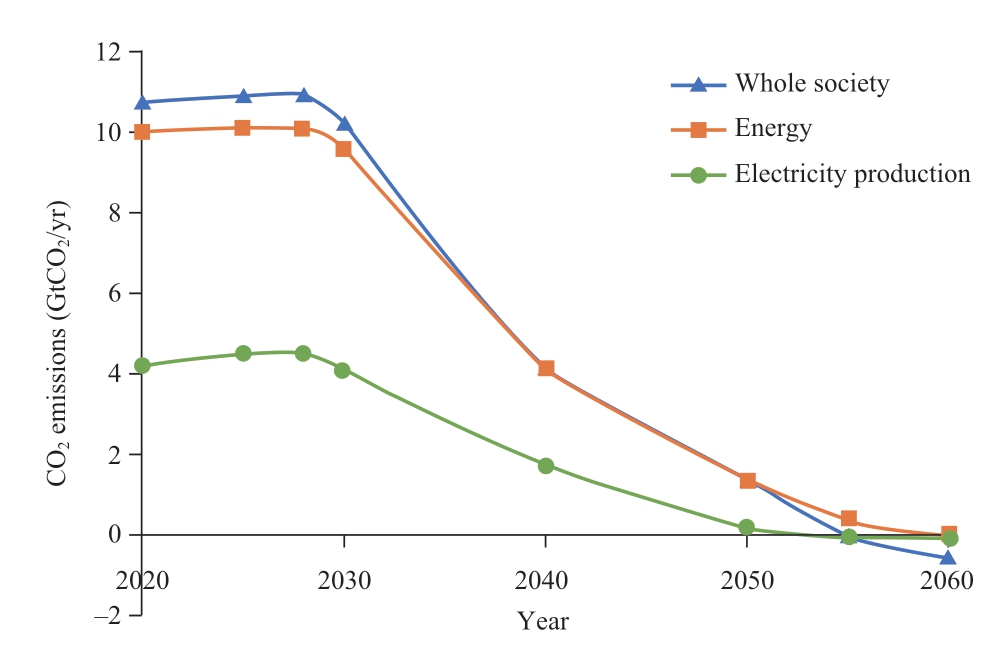
Fig.4 CO2 emissions of the whole society under the China Energy Interconnection carbon neutrality scenario
3.3 Benefit analysis
Achieving the goal of carbon neutrality will reduce air pollutant emissions and improve air quality.Compared with the BAU scenario,the CEICN scenario can effectively minimize environmental pollution.By 2060,the emissions of sulfur dioxide,nitrogen oxides,and fine particulate matter will drop by 15.8 million tonnes (91%),14.5 million tonnes(85%),and 4.3 million tonnes (90%),respectively,as shown in Fig.5.Compared to the ambitious-pollution-neutralgoals scenario in the study of Cheng et al.[18],NOx and PM2.5 emissions are around 60% lower,but SO2 emissions are around 65% higher.The difference is probably due to different emission inventories and models used in these two studies.

Fig.5 Emissions of SO2,NOx,and PM2.5 in the BAU and carbon neutrality scenarios.Baseline and ambitious-pollution-neutralgoals scenarios from Cheng et al.are referred to in this figure
From 2020 to 2060,a total loss of RMB 31 trillion is projected to be avoided in the agriculture,forestry,energy,water resources,climate disasters,and ecosystems sectors under the CEICN scenario,as shown in Fig.6.By 2060,the population-weighted PM2.5 concentration is around 10 μg/m3,over 80% decreasing from the 2015 level.The average annual PM2.5 concentration will meet the Grade I requirements (15 μg/m3) specified in the National Ambient Air Quality Standard,but the concentration is still above the newest WHO guideline of 5 μg/m3.Approximately 32 million premature deaths caused by air pollution will be avoided from 2020 to 2060,including 30 million and 2 million premature deaths avoided from reduced PM2.5 and O3 concentrations,respectively,with a cumulative loss of life value of 394 trillion CNY.The direct health impacts brought by achieving the goal of carbon neutrality will drive the proactive implementation of more emission reduction measures and bring greater benefits to human health.

Fig.6 Monetarized climate damages in the BAU and CEICN scenarios
Compared to other studies,the prediction of air pollutant concentration and avoided losses are within a reasonable range.Cheng et al.predicted that China’s carbon neutrality goals could make the majority of Chinese people be exposed to a PM2.5 concentration below 10 μg/m3 [18].Zhang et al.reported that 20-50 million cumulative premature deaths due to PM2.5 could be avoided over 2020-2060 by the realization of carbon neutrality goals [33].
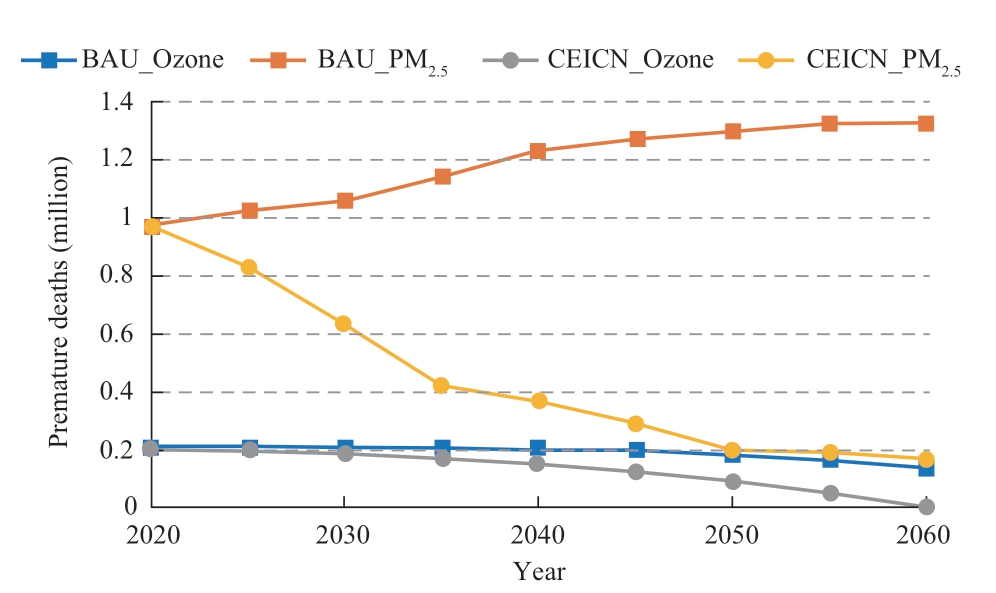
Fig.7 Premature deaths caused by PM2.5 and O3 in the BAU and carbon neutrality scenario
4 Conclusion and policy implications
Considering the coordinated development of energy,climate,environment,and health systems in China,no progress will be possible without well-coordinated toplevel design.China should hold the key to energy transition to foster synergic development from policy tools,scientific support,cross-sector interaction,and measures.
Based on the MESSAGE-GLOBIOM integrated assessment model,emission inventory and chemical transport model,and exposure-response function,a comprehensive assessment method of energy-climateair-health was developed.According to the findings,the Chinese Energy Interconnection is capable of promoting emission reduction,cutting air pollutant emissions by more than 85% in 2060,and improving health by avoiding 32 million premature deaths over 2020-2060.Building the Chinese Energy Interconnection will help develop a modernized energy system that features cleanness,high electrification,wide interconnection in the future,effectively promote the improvement of air quality,gain greater health benefits,and ensure that China’s carbon peak and carbon neutrality goals will be achieved.
Acknowledgements
This work was supported by the GEIGC Science and Technology Project in the framework of “Research on Comprehensive Path Evaluation Methods and Practical Models for the Synergetic Development of Global Energy,Atmospheric Environment and Human Health” (grant No.20210302007).We would like to thank anonymous reviewers for their valuable suggestions to help improve this manuscript.
Declaration of Competing Interest
We declare that we have no conflicts of interest.
References
[1]Ministry of Ecology and Environment of the People’s Republic of China (2021) China ecological and Environmental Status Bulletin 2020.https://www.mee.gov.cn/hjzl/sthjzk/zghjzkgb/202105/P020210526572756184785.pdf.Accessed 21 Sep 2022
[2]Chai Fahe (2020) China’s resultful air pollution control draws global praise.China Environment News
[3]Li J F,Li G (2020) Review and prospect of energy,environment and climate change in China.Environment and Sustainable Development,45(05):8-17
[4]Wang C,Deng H M,Guo K D,et al.(2020) Research progress on cooperative governance of greenhouse gases and air pollutants.Chinese Journal of Environmental Management,(4):5-12
[5]Xie Z H (2019) China’s historical evolution of environmental protection along the reform and opening-up over the last forty years: from the treatment of “three wastes” to the construction of ecological civilization.Chinese Journal of Environmental Management,11(4):5-10
[6]China Clean Air Policy Partnership (2020) Collaborative pathways to improve China’s air quality 2020: co-management of climate change and air pollution.http://www.ccapp.org.cn/dist/reportInfo/225.Accessed 21 Sep 2022
[7]Friedlingstein P,O’Sullivan M,Jones M,et al.(2020) Global carbon budget 2020.Earth System Science Data,12(4): 3269-3340
[8]Hong C P,Zhang Q,Zhang Y,et al.(2019) Impacts of climate change on future air quality and human health in China.Proceedings of the National Academy of Sciences of the United States of America,116(35): 17193-17200
[9]Bell M L,Goldberg R,Hogrefe C,et al.(2007) Climate change,ambient ozone,and health in 50 US cities.Climatic Change,82(1-2): 61-76
[10]Giorgini P,di Giosia P,Petrarca M,et al.(2017) Climate changes and human health: A review of the effect of environmental stressors on cardiovascular diseases across epidemiology and biological mechanisms.Current Pharmaceutical Design,23(22):3247-3261
[11]Kinney P L,(2018).Interactions of climate change,air pollution,and human health.Current Environmental Health Reports.5:179-186
[12]Rauner S,Hilaire J,Klein D,et al.(2020) Air quality co-benefits of ratcheting up the NDCs.Climatic Change,163(3): 1481-1500
[13]Rafaj P,Kiesewetter G,Krey V,et al.(2021) Air quality and health implications of 1.5 ℃-2 ℃ climate pathways under considerations of ageing population: A multi-model scenario analysis.Environmental Research Letters,16(4): 045005
[14]Chowdhury S,Dey S,Smith K R (2018) Ambient PM2.5 exposure and expected premature mortality to 2100 in India under climate change scenarios.Nature Communications,9: 318
[15]Amann M,Bertok I,Borken-Kleefeld J,et al.(2011) Costeffective control of air quality and greenhouse gases in Europe:Modeling and policy applications.Environmental Modelling &Software,26(12): 1489-1501
[16]Xing J,Lu X,Wang S X,et al.(2020) The quest for improved air quality may push China to continue its CO2 reduction beyond the Paris Commitment.Proceedings of the National Academy of Sciences of the United States of America,117(47): 29535-29542
[17]Chang S Y,Yang X,Zheng H T,et al.(2020) Air quality and health co-benefits of China’s national emission trading system.Applied Energy,261: 114226
[18]Cheng J,Tong D,Zhang Q,et al.(2021) Pathways of China’s PM2.5 air quality 2015-2060 in the context of carbon neutrality.National Science Review,8(12): 63-73
[19]Huppmann D,Gidden M,Fricko O,et al.(2019) The MESSAGEix Integrated Assessment Model and the ix modeling platform (ixmp): An open framework for integrated and crosscutting analysis of energy,climate,the environment,and sustainable development.Environmental Modelling &Software,112: 143-156
[20]Zhao Z J,Chen X T,Liu C Y,et al.(2020) Global climate damage in 2 ℃ and 1.5 ℃ scenarios based on BCC_SESM model in IAM framework.Advances in Climate Change Research,11(3): 261-272
[21]United Nation Standard (2022) https://population.un.org/wpp/Download/Standard/Population/.Accessed 20 May 2022
[22]Scovronick N,Budolfson M,Dennig F,et al.(2019) The impact of human health co-benefits on evaluations of global climate policy.Nature Communications,10: 2095
[23]Zhang Y Q,Shindell D,Seltzer K,et al.(2021) Impacts of emission changes in China from 2010 to 2017 on domestic and intercontinental air quality and health effect.Atmospheric Chemistry and Physics,21(20): 16051-16065
[24]Limaye V S,Schöpp W,Amann M (2018) Applying integrated exposure-response functions to PM2.5 pollution in India.International Journal of Environmental Research and Public Health,16(1): 60
[25]Zhang S H,Worrell E,Crijns-Graus W,et al.(2016) Modeling energy efficiency to improve air quality and health effects of China's cement industry.Applied Energy,184: 574-593
[26]Wagner F,Borken-Kleefeld J,Kiesewetter G,et al.(2018) The GAINS PMEH-Methodology Version 2.0.IIASA.https://pure.iiasa.ac.at/id/eprint/15695/.Accessed 21 Sep 2022
[27]Anderson H R,Atkinson R W,Peacock J L,et al.(2004) Metaanalysis of time-series studies and panel studies of Particulate Matter (PM) and Ozone (O3).https://apps.who.int/iris/handle/10665/107557.Accessed 21 Sep 2022
[28]Dong Z M,Wang H,Yin P,et al.(2020) Time-weighted average of fine particulate matter exposure and cause-specific mortality in China: A nationwide analysis.The Lancet Planetary Health,4(8):e343-e351
[29]Burnett R T,Pope C A 3rd,Ezzati M,et al.(2014) An integrated risk function for estimating the global burden of disease attributable to ambient fine particulate matter exposure.Environmental Health Perspectives,122(4): 397-403
[30]Sun H Z,Yu P,Lan C X,et al.(2022) Long-term ozone exposure associated cause-specific mortality risks with adjusted metrics by cohort studies: A systematic review and meta-analysis.https://www.medrxiv.org/content/10.1101/2021.12.02.21267196v2.Accessed 21 Sep 2022
[31]Jerrett M,Burnett R T,Pope C A,et al.(2009) Long-term ozone exposure and mortality.The New England Journal of Medicine,360(11): 1085-1095
[32]Cao C J,Song X K,Cai W J,et al.(2021) Estimating the value of statistical life in China: A contingent valuation study in six representative cities.https://assets.researchsquare.com/files/rs-199197/v1_covered.pdf?c=1631852934.Accessed 21 Sep 2022
[33]Markandya A,Sampedro J,Smith S J,et al.(2018) Health cobenefits from air pollution and mitigation costs of the Paris Agreement: A modelling study.The Lancet Planetary Health,2(3): e126-e133
[34]Zhang S H,An K X,Li J,et al.(2021) Incorporating health cobenefits into technology pathways to achieve China’s 2060 carbon neutrality goal: A modelling study.The Lancet Planetary Health,5(11): e808-e817
[35]Chen X T,Yang F,Zhang S N,et al.(2021) Regional emission pathways,energy transition paths and cost analysis under various effort-sharing approaches for meeting Paris Agreement goals.Energy,232: 121024
[36]Höhne N,den Elzen M,Escalante D (2014) Regional GHG reduction targets based on effort sharing: A comparison of studies.Climate Policy,14(1): 122-147
[37]Ma Z Y,Zhang S N,Hou F X,et al.(2020) Exploring the driving factors and their mitigation potential in global energy-related CO2 emission.Global Energy Interconnection,3(5): 413-422
[38]Zhou Y B,Chen X,Tan X,et al.(2018) Mechanism of CO2 emission reduction by global energy interconnection.Global Energy Interconnection,1(4): 409-419
[39]GEIDCO,IIASA,WHO (2019) Research Report on Global Energy Interconnection for Addressing Climate Change,Beijing:China Electric Power Press
[40]GEIDCO (2021) Research Report on China’s Target of Carbon Neutrality Before 2060.https://www.geidco.org.cn/html/qqnyhlw/zt20210120_1/index.html.Accessed 21 Sep 2022
Appendix
GEICN Scenario description
Considering the growth trends of production factors such as capital,labor,human resources,and total factor productivity,and with reference to domestic and international studies on economic growth forecasts,the average economic growth rate is expected to reach 5.3% in the 14th Five-Year Plan period.From 2025 to 2035,China’s economic growth will gradually shift to the stage of medium growth (above 4%).Total GDP is expected to reach RMB 208 trillion by 2035,realizing the long-term goal of doubling the GDP in 2019.GDP will reach RMB 338 trillion and RMB 435 trillion in 2050 and 2060,respectively.
China is expected to make the transition from late industrialization to post-industrialization from 2020 to 2035.It is estimated that the proportion of primary,secondary,and tertiary sectors will be 5: 36: 59 in 2035.From 2035 to the middle of the century,China will enter the stage of post-industrialization and make the transition to the era of the service and knowledge economies.Combining the current historical trend of industrial structure change in developed countries and the forecast of mainstream research institutions,it is estimated that the proportion of primary,secondary,and tertiary sectors in China will be 4: 33: 63 and 4: 30: 66 in 2050 and 2060,respectively.
This study uses the population data in the medium scenario from the UN’s World Population Prospects 2019,with a total population of about 1.461 billion in 2035,dropping to 1.333 billion in 2060.Combined with the forecast of China’s medium-and long-term economic development,it is expected that the 14th Five-Year Plan will start a new round of new urbanization construction,and the urbanization rate will maintain a fast growth rate.It is estimated that the urbanization rate will reach 68%~73% in 2035 and will slow down after 2035,reaching 78%~81% in 2050 and 83%~85% in 2060.
Energy is the top priority in achieving carbon neutrality.Achieving carbon neutrality will form a clean energydominant,electricity-centric,and widely interconnected new global energy system.It will rely on the solid backbone grid to adjust power flexibly to facilitate a revolution in the global energy pattern.
By 2060,the total primary energy consumption will stabilize at approximately 6 Gtce,and the electricity consumed by the whole society will continuously grow to 17 PWh.The proportion of clean energy on the production side will double,and the share of clean energy in primary energy consumption will rise from 31% in 2030 to 90% in 2060 shown in Fig.A1.
The electrification level on the consumption side will double,and the share of electricity in end-use energy consumption will grow from 33% in 2030 to 66% in 2060,as shown in Fig.A2.
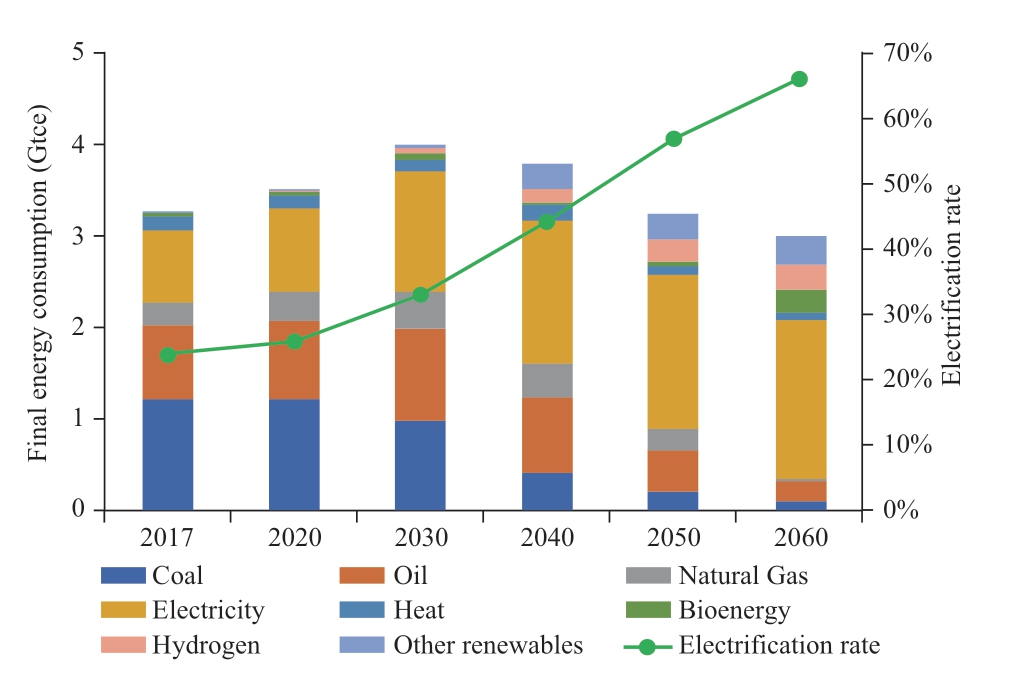
Fig.A2 Projection of final energy consumption and structure in the CEICN scenario
The energy deployment will feature extensive interconnection.By 2030,the power flow across regions and provinces will reach 460 GW,and the cross-country power flow will be approximately 42.5 GW;and these two numbers will increase to 830 GW and roughly 187 GW by 2060,respectively.
Received: 26 September 2021/Accepted: 20 May 2022/Published: 25 October 2022
 Xiaotong Chen
Xiaotong Chen
xiaotong-chen@geidco.org
Jianxiang Shen
shenjx21@mails.tsinghua.edu.cn
Xing Chen
xing-chen@geidco.org
Zijian Zhao
zijian-zhao@geidco.org
Zhiyuan Ma
zhiyuan-ma@geidco.org
Fang Yang
fang-yang1@geidco.org
Shaohui Zhang
shaohui.zhang@iiasa.ac.at
Wenjia Cai
wcai@tsinghua.edu.cn
2096-5117/© 2022 Global Energy Interconnection Development and Cooperation Organization.Production and hosting by Elsevier B.V.on behalf of KeAi Communications Co.,Ltd.This is an open access article under the CC BY-NC-ND license (http://creativecommons.org/licenses/by-nc-nd/4.0/).
Biographies

Jianxiang Shen received his B.E.degree in environmental science from Nanjing University,China in 2021.Currently,he is a Ph.D student in Department of Earth System Science,Tsinghua University,China.His research interest is health and economic impacts of action and inaction on climate change,development of the integrated assessment models,as well as mitigation strategy of plant-level infrastructure.

Wenjia Cai is an associate professor of global change economics in Department of Earth System Science,Tsinghua University,China.Her research interest is the health and economic impacts of action and inaction on climate change,as well as the climate policy design.She is now a member of Global Air Pollution and Health-Technical Advisory Group of the World Health Organization,and she also serves as the Director of Lancet Countdown Asia.

Xiaotong Chen received her B.E.and Ph.D.degrees in environmental science and engineering from Tsinghua University,Beijing,China,in 2015 and 2019,respectively.Currently,she works at the Global Energy Interconnection Development and Cooperation Organization (GEIDCO).Her research interests include integrated assessment modeling,costbenefit analysis of energy and climate policies,and air pollution measurement and control.

Xing Chen received her Ph.D.degree from the Tsinghua University,Beijing in 2017.She is now working at the Global Energy Interconnection Development and Cooperation Organization (GEIDCO).Her research interests include environmental system analysis,climate change,low-carbon and carbon neutrality policy,and energy planning.

Zijian Zhao received her B.E.degree from the Nanjing University of Science and Technology,Jiangsu,China,in 2014,and Ph.D.degree from Tsinghua University,Beijing,China,in 2019.Currently,she works at the Global Energy Interconnection Development and Cooperation Organization (GEIDCO).Her research interests include climate change mitigation,atmospheric chemistry,and energy policy.

Zhiyuan Ma received her B.E.degree from the Shandong University of Science and Technology,Shandong,China,in 2011,the M.S.and Ph.D degrees in electrical engineering from Tsinghua University,Beijing,China,in 2014 and 2018,respectively.Currently,she works at the Global Energy Interconnection Development and Cooperation Organization(GEIDCO).Her research interests include climate change mitigation,energy and power systems.

Fang Yang received her B.E.and Ph.D.degrees in electrical engineering from Tsinghua University,Beijing,China,in 2004 and 2010,respectively.Currently,she is a Division Director of the Climate Change &Environment Research Division at the Global Energy Interconnection Development and Cooperation Organization (GEIDCO).Her research interests include climate change,energy and power systems,and environmental research.

Shaohui Zhang is a guest research scholar in the Pollution Management (PM) research group of the IIASA Energy,Climate,and Environment (ECE) program,and an associate professor at Beihang University(BUAA) in China.He received his PhD from the Copernicus Institute of Sustainable Development at Utrecht University,the Netherlands,following the completion of an MSc at Zhengzhou University,China.His research interests focus on development and application of the GAINS and MESSAGEix integrated assessment models,technology and policy assessment for energy,climate,and environmental pollution,as well as cost-benefit analysis.
(Editor Dawei Wang)
